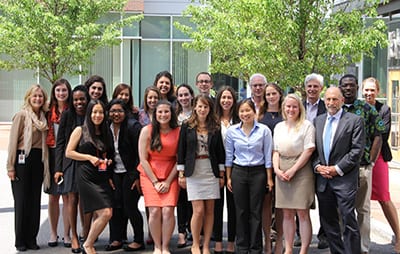Intensive Program Design Class at SPH Creates Solutions for Global Problems
In just nine frenetic, coffee-fueled days this summer, students in Global Health 744 at the BU School of Public Health created detailed plans to:
- Improve monitoring of anti-retroviral drug treatment in India
- Increase staff training for a Haitian hospital’s new maternal health ward
- Use existing household delivery schemes to disburse family planning in Kenya
- Build a community health center in rural Kenya
- And rehabilitate existing solar-powered wells in Tanzania

Students in IH 744 join panelists and instructors after delivering their presentations.
The class – Program Design for Global Health – is an intensive exercise in team-building and creative collaboration that produces comprehensive, strategically solid planning for a host of non-profit groups around the world. The students hunkered down in a large classroom space in the Crosstown Building to exchange ideas about capacity building, infrastructure improvements, and a host of other concepts that could have easily filled an entire semester.
Students in GH 744 join panelists and instructors after delivering their presentations.
“Nine days ago we walked into this room and we didn’t know each other, we didn’t know our clients. All we knew is that would be creating the type of programs that would truly help people in the communities our clients serve,” said James Wolff, an associate professor of international health.
Wolff, who is a former senior fellow at Management Sciences for Health (MSH), a non-profit international public health management consulting company, has taught the course for five summers with help from other experts in the field. This summer he teamed with Cristin Marona, a global technical advisor at the Futures Group, an international development and health consultancy with offices around the world. The blend of academic rigor and applied knowledge has made the novel course a student favorite.
A panel of guest reviewers evaluates the projects, using their decades of experience to identify each plan’s strengths and weaknesses. This year, the reviewers were: David Barash, M.D., the executive director of the Global Health Portfolio and chief medical officer of the General Electric Foundation; Lynn Black, M.D., MPH, chief medical officer, International Medical and Surgical Response Team, U.S. Department of Health and Human Services; John Ettinger, J.D., chief executive officer at the Helmsley Charitable Trust; and Gretchen Stoddard, MPH, program officer at the IZUMI Foundation.
The projects ranged in scope and complexity from simple supply infrastructure changes to ambitious developments of community health centers. A team of students designed a program for the New Delhi National Aids Control Society that would enable local health care providers to better monitor follow-up care of people receiving anti-retroviral drug treatments. Estimated cost for the two-year program was $4,000, including a separate evaluation component to track long-term outcomes and the effectiveness of the overall program.
St. Boniface Haiti Foundation has partnered with IH 744 students for several years to help improve health care, educational opportunities and community development in a large area of southern Haiti. The foundation runs St. Boniface Hospital, which serves more than 120,000 as one of the impoverished region’s few large health-care providers.
This year, students created a plan to increase staff capacity and training for the hospital’s new maternal and neonatal care unit. The expanded facility requires about 20 percent more staff – a daunting challenge in a rural, underserved area – but the IH744 students developed a plan to cross-train many existing staff on specialized equipment and methods of neonatal care.
Students working for the One Acre Fund in Kenya, an agricultural microlender that boosts local economies by supporting individual farmers, responded to a request to incorporate family planning into the fund’s current model of providing farming assistance.
Their solution: use the fund’s existing network of seed and fertilizer deliveries, bought on credit at extremely low rates, to deliver family planning information and supplies. The microlender model has been successful in Kenya, with a 99 percent repayment rate, the students noted.
Another team tackled the challenge of staffing and training community health workers for a proposed community health center in the coastal settlement of Kikambala, Kenya. Students developed a series of goals for the center and a plan for monitoring and evaluating the progress toward them. This ambitious, $620,000 plan included construction costs for building the center and operating costs for the first five years.
“More than Water,” an innovative scheme to update and rehabilitate existing solar-powered wells in Tanzania, was an interesting combination of a philanthropic and private-sector business plan that intrigued the invited review panelists.
“Sometimes the philanthropic world too quickly dismisses the for-profit models,” said Ettinger. “If you add a charitable element to it, it can be a very effective way of effecting social change.”